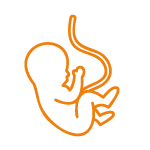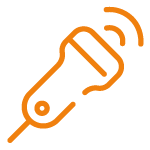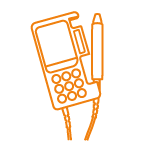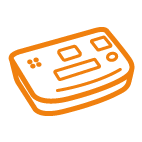Frequently asked patient questions (FAQs)
Frequently asked patient questions (FAQs)
Contents
At this point we would like to help you with answers to frequently asked questions from the patient area:
Yes, if the catheter has been rolled up into a snail and placed on the dressing material and the shower film dressing carefully encloses the entire dressing material.
Our recommendation: Take a shower before you drain and change the dressing. If the dressing becomes soaked while showering, it will be replaced promptly.
The skin suture (the suture furthest from the catheter exit site) can be removed after 10 days and the retaining suture (the suture directly at the catheter exit) after 30 days. The sutures are usually removed on an outpatient basis in the hospital/clinic where the catheter was implanted. However, the stitches can also be removed by the family doctor.
There is no time limit for leaving the catheter in place. If no signs of infection, such as redness, swelling or overheating, are associated with the catheter and the catheter is functioning properly, the catheter should remain in place and not be changed. If you are unsure, ask your doctor.
The material prescribed by your doctor will be sent to your home postage-free by fenik AG after you leave hospital. If you need additional drainage sets, you can order them directly from fenik AG on this website, by telephone or e-mail. Prescription drainage sets are not available from medical supply stores or pharmacies, so we can advise you on the correct use at any time.
Further information on this can be found in the fenik service and supply concept
You can also use the drainage material abroad. When preparing for your trip, you must ensure that you order sufficient drainage material in advance. Please also observe the usual disposal regulations of the respective country.
Yes, you will receive personal instructions on draining the effusion from our product specialist after leaving the hospital or clinic. He will explain to you step-by-step and show you what you need to bear in mind. Finally, he will also give you our patient folder, in which all the information is available for you to read again.
If an effusion no longer forms or your treating physicians decide to remove the catheter for other reasons, the catheter can also be removed under local anesthesia.
Yes, we have many years of experience in the drainage of pleural effusions and ascites. Every year, several thousand patients receive a pleural catheter and regain some of their quality of life and mobility.
If the catheter has been completely and correctly covered with the self-adhesive film dressing, you may shower. If the gauze compresses get wet while showering, remove the dressing, clean and dry the area and apply a new dressing. The catheter must not be immersed in water in a bath or swimming pool.
Discuss this question with your doctor before you travel. Depending on your individual condition, he or she will be able to provide you with information on this.
In any case, you should also remember to order sufficient drainage material in advance if you are going on a longer trip. See also Can I go on vacation with it? Even abroad?
If you have any complaints regarding your catheter or effusion during your trip, consult a local doctor immediately.
Yes, improper handling can damage the catheter. Please read the instructions for use carefully. Only use alcohol-based disinfectants for skin and hand disinfection
No, the drainage set is intended for single use and must not be used more than once for reasons of hygiene and the risk of infection.
After drainage, please dispose of the used drainage material in the household waste. Please observe the local regulations for disposal.
If you still do not feel any relief when breathing after the drainage has been carried out, contact your doctor. Your doctor or the clinic treating you knows the course of your illness and can tell you the cause after an examination.
If the color or composition of the effusion changes, this is not an acutely threatening situation. Your doctor will be able to explain the cause of this based on the course of your illness. If the effusion becomes cloudy or there is even fresh blood in the effusion, you should contact your doctor.
If the effusion stops during drainage, there may be several reasons for this. The most pleasant reason is that there is no more effusion. If this happens more often, consult your doctor and the catheter may even be explanted. Another reason could be a blockage of the drainage tube, which can be caused by a viscous effusion. In this case, you can try to mobilize the blockage by gently “milking” the drainage tube so that the effusion flows again or the catheter must be flushed. Please contact your doctor for advice.
How can I “milk” the catheter?
In preparation, the catheter must be connected to a reservoir so that the blockage and any accumulation of effusion can drain directly. Put on disposable gloves and moisten them with hand sanitizer so that the catheter can slide between your fingers. If large particles are visible, squeeze them together. Then hold the catheter close to the exit point with one hand so that there is no great tension at the exit point. With the other hand, squeeze the catheter near the exit point and push it out in the direction of the safety valve. If nothing comes loose, repeat the process several times.
No, the drainage sets are not available in pharmacies or medical supply stores, but exclusively from fenik AG.
Ordering options
- Please use the order form on our website.
- Send us an e-mail to info@fenik.ch
- Call us on the main telephone number +41 52 577 02 55 or service telephone number +41 31 511 87 20
Questions about billing
No, the drainage sets are not available in pharmacies or medical supply stores, but exclusively from ewimed Switzerland AG.
Ordering options
- Please use the order form on our website.
- Send us an e-mail to info.ch@ewimed.com
- Call us on the main telephone number +41 52 577 02 55 or service telephone number +41 31 511 87 20
Drainage sets are reimbursed by the health insurance company after receipt of a doctor’s prescription!
If you have any further questions or if the answers described are not suitable, please contact fenik at any time at info@fenik.ch, +41 52 577 02 55 or +41 31 511 87 20 or use the contact form. We will be happy to help you.




